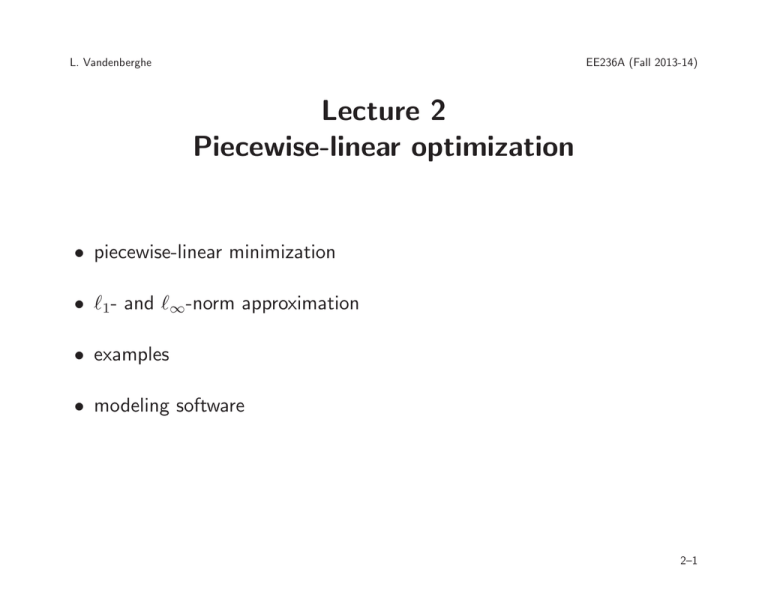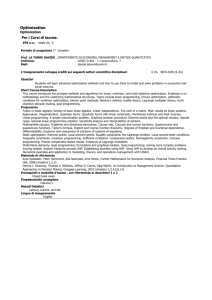Lecture 2 Piecewise-linear optimization
advertisement

L. Vandenberghe
EE236A (Fall 2013-14)
Lecture 2
Piecewise-linear optimization
• piecewise-linear minimization
• ℓ1- and ℓ∞-norm approximation
• examples
• modeling software
2–1
Linear and affine functions
linear function: a function f : Rn → R is linear if
f (αx + βy) = αf (x) + βf (y)
∀x, y ∈ Rn, α, β ∈ R
property: f is linear if and only if f (x) = aT x for some a
affine function: a function f : Rn → R is affine if
f (αx + (1 − α)y) = αf (x) + (1 − α)f (y)
∀x, y ∈ Rn, α ∈ R
property: f is affine if and only if f (x) = aT x + b for some a, b
Piecewise-linear optimization
2–2
Piecewise-linear function
f : Rn → R is (convex) piecewise-linear if it can be expressed as
f (x) = max (aTi x + bi)
i=1,...,m
f is parameterized by m n-vectors ai and m scalars bi
f (x)
aTi x + bi
x
(the term piecewise-affine is more accurate but less common)
Piecewise-linear optimization
2–3
Piecewise-linear minimization
minimize f (x) = max (aTi x + bi)
i=1,...,m
• equivalent LP (with variables x and auxiliary scalar variable t)
minimize t
subject to aTi x + bi ≤ t,
i = 1, . . . , m
to see equivalence, note that for fixed x the optimal t is t = f (x)
• LP in matrix notation: minimize c̃T x̃ subject to Ãx̃ ≤ b̃ with
x̃ =
x
t
,
Piecewise-linear optimization
c̃ =
0
1
,
aT1
à = ..
aTm
−1
.. ,
−1
−b1
b̃ = ..
−bm
2–4
Minimizing a sum of piecewise-linear functions
minimize f (x) + g(x) = max (aTi x + bi) + max (cTi x + di)
i=1,...,m
i=1,...,p
• cost function is piecewise-linear: maximum of mp affine functions
f (x) + g(x) = max
i=1,...,m
j=1,...,p
T
(ai + cj ) x + (bi + dj )
• equivalent LP with m + p inequalities
minimize t1 + t2
subject to aTi x + bi ≤ t1,
cTi x + di ≤ t2,
i = 1, . . . , m
i = 1, . . . , p
note that for fixed x, optimal t1, t2 are t1 = f (x), t2 = g(x)
Piecewise-linear optimization
2–5
• equivalent LP in matrix notation
minimize c̃T x̃
subject to Ãx̃ ≤ b̃
with
x
x̃ = t1 ,
t2
Piecewise-linear optimization
0
c̃ = 1 ,
1
à =
aT1
..
aTm
cT1
..
cTp
−1 0
..
..
−1 0
,
0 −1
..
..
0 −1
b̃ =
−b1
..
−bm
−d1
..
−dp
2–6
ℓ∞-Norm (Cheybshev) approximation
minimize kAx − bk∞
with A ∈ Rm×n, b ∈ Rm
• ℓ∞-norm (Chebyshev norm) of m-vector y is
kyk∞ = max |yi| = max max{yi, −yi}
i=1,...,m
i=1,...,m
• equivalent LP (with variables x and auxiliary scalar variable t)
minimize t
subject to −t1 ≤ Ax − b ≤ t1
(for fixed x, optimal t is t = kAx − bk∞)
Piecewise-linear optimization
2–7
• equivalent LP in matrix notation
Piecewise-linear optimization
minimize
subject to
0
1
T x
t
A −1
−A −1
x
t
≤
b
−b
2–8
ℓ1-Norm approximation
minimize kAx − bk1
• ℓ1-norm of m-vector y is
kyk1 =
m
X
|yi| =
i=1
m
X
max{yi, −yi}
i=1
• equivalent LP (with variable x and auxiliary vector variable u)
minimize
m
P
ui
i=1
subject to −u ≤ Ax − b ≤ u
(for fixed x, optimal u is ui = |(Ax − b)i|, i = 1, . . . , m)
Piecewise-linear optimization
2–9
• equivalent LP in matrix notation
Piecewise-linear optimization
minimize
subject to
0
1
T x
u
A −I
−A −I
x
u
≤
b
−b
2–10
Comparison with least-squares solution
histograms of residuals Ax − b, with randomly generated A ∈ R200×80, for
xℓ1 = argmin kAx − bk1
xls = argmin kAx − bk,
10
8
6
4
2
0
1.5
1.0
0.5
0.0
0.5
1.0
1.5
(Axls − b)k
100
80
60
40
1.0
0
1.5
20
0.5
0.0
0.5
1.0
1.5
(Axℓ1 − b)k
ℓ1-norm distribution is wider with a high peak at zero
Piecewise-linear optimization
2–11
Robust curve fitting
• fit affine function f (t) = α + βt to m points (ti, yi)
• an approximation problem Ax ≈ b with
1 t1
α
.
.
. .
,
x=
,
A=
β
1 tm
y1
b = ..
ym
25
20
15
• dashed: minimize kAx − bk
10
• solid: minimize kAx − bk1
f (t)
5
0
15
20 10
10
ℓ1-norm approximation is more
robust against outliers
5
5
0
5
10
t
Piecewise-linear optimization
2–12
Sparse signal recovery via ℓ1-norm minimization
• x̂ ∈ Rn is unknown signal, known to be very sparse
• we make linear measurements y = Ax̂ with A ∈ Rm×n, m < n
estimation by ℓ1-norm minimization: compute estimate by solving
minimize kxk1
subject to Ax = y
estimate is signal with smallest ℓ1-norm, consistent with measurements
equivalent LP (variables x, u ∈ Rn)
minimize 1T u
subject to −u ≤ x ≤ u
Ax = y
Piecewise-linear optimization
2–13
Example
2
1
x̂k
• exact signal x̂ ∈ R
1000
• 10 nonzero components
0
−1
−2
0
200
400
600
800
1000
k
least-norm solutions (randomly generated A ∈ R100×1000)
minimum ℓ1-norm solution
2
2
1
1
xk
xk
minimum ℓ2-norm solution
0
0
−1
−1
−2
−2
0
200
400
600
k
800
1000
0
200
400
600
800
1000
k
ℓ1-norm estimate is exact
Piecewise-linear optimization
2–14
Exact recovery
when are the following problems equivalent?
minimize card(x)
subject to Ax = y
minimize kxk1
subject to Ax = y
• card(x) is cardinality (number of nonzero components) of x
• depends on A and cardinality of sparsest solution of Ax = y
we say A allows exact recovery of k-sparse vectors if
x̂ = argmin kxk1
when y = Ax̂ and card(x̂) ≤ k
Ax=y
• here, argmin kxk1 denotes the unique minimizer
• a property of (the nullspace) of the ‘measurement matrix’ A
Piecewise-linear optimization
2–15
‘Nullspace condition’ for exact recovery
necessary and sufficient condition for exact recovery of k-sparse vectors1
|z
(1)
| + · · · + |z
(k)
1
| < kzk1
2
∀z ∈ nullspace(A) \ {0}
here, z (i) denotes component zi in order of decreasing magnitude
|z (1)| ≥ |z (2)| ≥ · · · ≥ |z (n)|
• a bound on how ‘concentrated’ nonzero vectors in nullspace(A) can be
• implies k < n/2
• difficult to verify for general A
• holds with high probability for certain distributions of random A
1
Feuer & Nemirovski (IEEE Trans. IT, 2003) and several other papers on compressed sensing.
Piecewise-linear optimization
2–16
Proof of nullspace condition
notation
• x has support I ⊆ {1, 2, . . . , n} if xi = 0 for i 6∈ I
• |I| is number of elements in I
• PI is projection matrix on n-vectors with support I: PI is diagonal with
(PI )jj =
1 j∈I
0 otherwise
• A satisfies the nullspace condition if
1
kPI zk1 < kzk1
2
for all nonzero z in nullspace(A) and for all support sets I with |I| ≤ k
Piecewise-linear optimization
2–17
sufficiency: suppose A satisfies the nullspace condition
• let x̂ be k-sparse with support I (i.e., with PI x̂ = x̂); define y = Ax̂
• consider any feasible x (i.e., satisfying Ax = y), different from x̂
• define z = x − x̂; this is a nonzero vector in nullspace(A)
kxk1 = kx̂ + zk1
≥ kx̂ + z − PI zk1 − kPI zk1
X
X
=
|x̂k | +
|zk | − kPI zk1
k∈I
k6∈I
= kx̂k1 + kzk1 − 2kPI zk1
> kx̂k1
(line 2 is the triangle inequality; the last line is the nullspace condition)
therefore x̂ = argminAx=y kxk1
Piecewise-linear optimization
2–18
necessity: suppose A does not satisfy the nullspace condition
• for some nonzero z ∈ nullspace(A) and support set I with |I| ≤ k,
1
kPI zk1 ≥ kzk1
2
• define a k-sparse vector x̂ = −PI z and y = Ax̂
• the vector x = x̂ + z satisfies Ax = y and has ℓ1-norm
kxk1 = k − PI z + zk1
= kzk1 − kPI zk1
≤ 2kPI zk1 − kPI zk1
= kx̂k1
therefore x̂ is not the unique ℓ1-minimizer
Piecewise-linear optimization
2–19
Linear classification
• given a set of points {v1, . . . , vN } with binary labels si ∈ {−1, 1}
• find hyperplane that strictly separates the two classes
aT vi + b > 0
if si = 1
aT vi + b < 0 if si = −1
homogeneous in a, b, hence equivalent to the linear inequalities (in a, b)
si(aT vi + b) ≥ 1,
Piecewise-linear optimization
i = 1, . . . , N
2–20
Approximate linear separation of non-separable sets
minimize
N
X
max{0, 1 − si(aT vi + b)}
i=1
• penalty 1 − si(aTi vi + b) for misclassifying point vi
• can be interpreted as a heuristic for minimizing #misclassified points
• a piecewise-linear minimization problem with variables a, b
Piecewise-linear optimization
2–21
equivalent LP (variables a ∈ Rn, b ∈ R, u ∈ RN )
minimize
N
P
ui
i=1
subject to 1 − si(viT a + b) ≤ ui, i = 1, . . . , N
ui ≥ 0, i = 1, . . . , N
in matrix notation:
T
0
minimize 0
1
−s1v1T
−s2v2T
..
−sN v T
N
subject to
0
0
..
0
Piecewise-linear optimization
a
b
u
−s1
−s2
..
−sN
0
0
..
0
−1 0 · · ·
0 −1 · · ·
..
..
...
0
0 ···
−1 0 · · ·
0 −1 · · ·
..
..
...
0
0 ···
0
0
..
−1
0
0
..
−1
a
b
u1
u2
..
uN
≤
−1
−1
..
−1
0
0
..
0
2–22
Modeling software
modeling tools simplify the formulation of LPs (and other problems)
• accept optimization problem in standard notation (max, k · k1, . . . )
• recognize problems that can be converted to LPs
• express the problem in the input format required by a specific LP solver
examples of modeling packages
• AMPL, GAMS
• CVX, YALMIP (MATLAB)
• CVXPY, Pyomo, CVXOPT (Python)
Piecewise-linear optimization
2–23
CVX example
minimize kAx − bk1
subject to 0 ≤ xk ≤ 1,
k = 1, . . . , n
MATLAB code
cvx_begin
variable x(n);
minimize( norm(A*x - b, 1) )
subject to
x >= 0
x <= 1
cvx_end
• between cvx_begin and cvx_end, x is a CVX variable
• after execution, x is MATLAB variable with optimal solution
Piecewise-linear optimization
2–24


